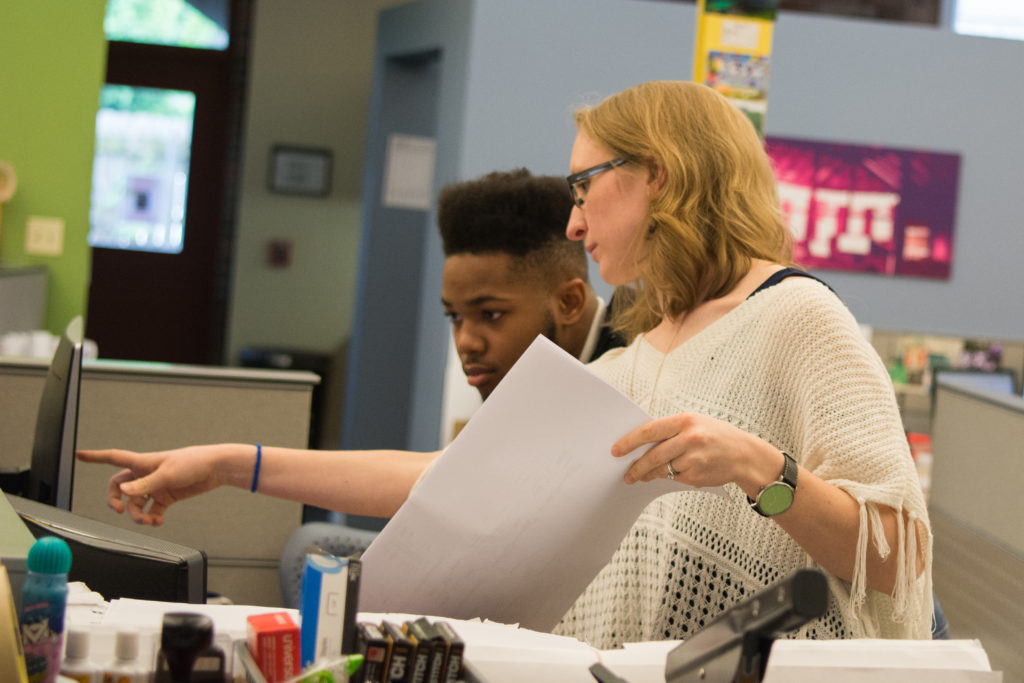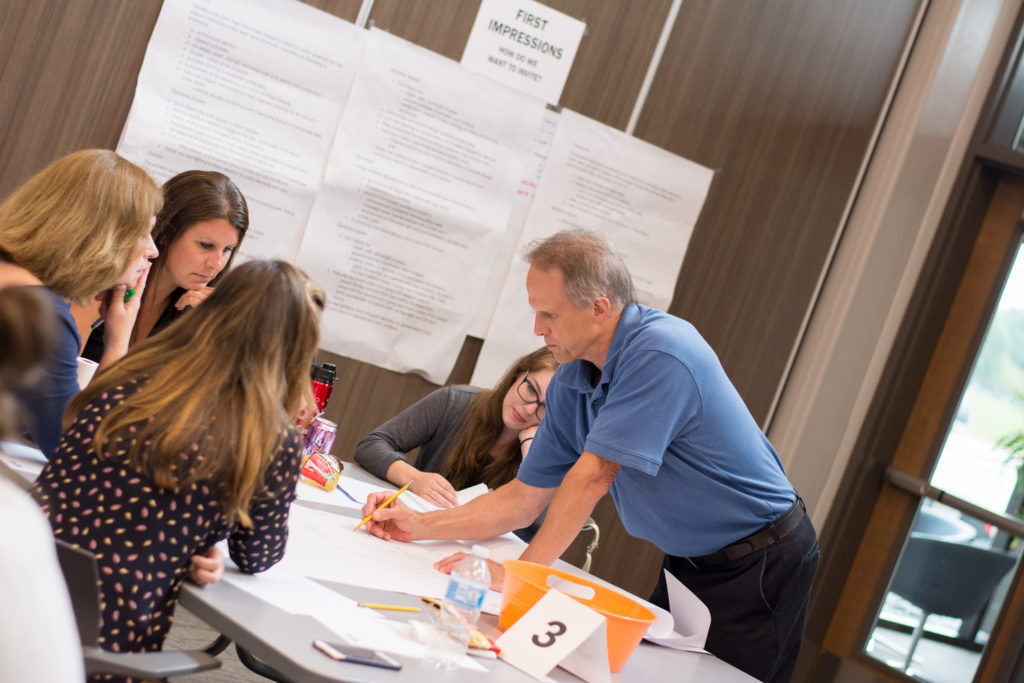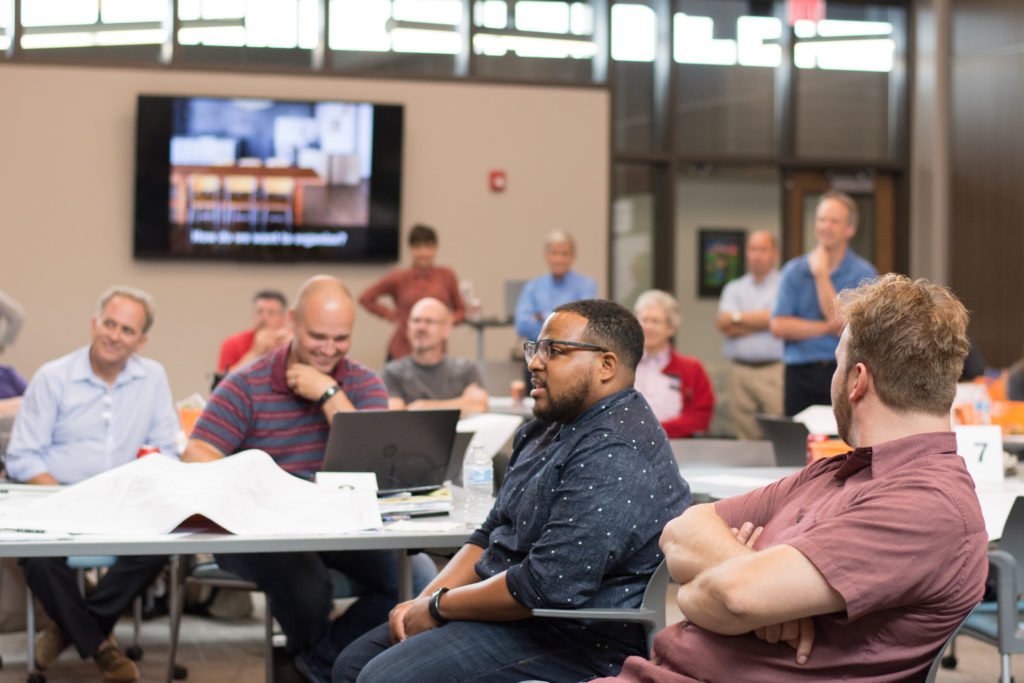Against the backdrop of one of Cleveland’s most popular bars, a small environmental project has made big impacts on the design of a little green roof in dense urban environments. In 2013, Claire Bank, an architect with ThenDesign Architecture (TDA), managed a green roof project that was installed on one of Cleveland’s popular “Bike Box” installations and sought to demonstrate a new way to think about sustainability in a concrete jungle. Now, this internationally recognized project has attracted hundreds of professionals annually, showing them a new way to integrate native plant species into an otherwise inhospitable environment.
Challenging Environmental Context
Deep in the Gordan Square Arts District, sits the Happy Dog, one of Cleveland’s most popular bars. This local joint established itself as one of the most welcoming live music venues in Cleveland. Situated on Detroit Ave, in a dense urban environment that historically hosted music and food venues, the owners of the bar, along with partners at the Gordan Square Arts District and local musicians have been able to attract talent from across the country. With a menu that eschews exotic items, they focus on their staple–hot dogs–and offer a dizzying array of homemade and unique toppings. So this menu, with live music and a monthly TEDx style talk with scientists, writers and academics, they maintain their status as an educational, community oriented location.
However, like many venues set in an urban context, this corner bar is adrift in a sea of pavement. Detroit Ave, is a heavily trafficked city street that runs parallel to Lake Erie, through the City of Cleveland, Ohio City and the Gordan Square Arts District. On this busy thoroughfare, semi-trucks, delivery vehicles, city buses, commuter cars, construction trucks and many other vehicles frequent the road. Adding to this activity, is a bike path in this corridor which provides alternate means of transportation and seeks to encourage more pedestrian use.
The impervious city pavement stretches as far as the eye can see. This ground covering is a slick surface that does nothing to slow or capture rainfall that rushes directly into city sewers. During rainy seasons, a common issue in Northeast Ohio, water streams across the road surface, creating flooding and taxes the city sewer systems. Additionally, during winter months, salt, from deicing frozen roads collects in pools and is deadly for most plant material. In addition, vast expanses of pavement contribute to climate change, as the dark asphalt holds on to heat another challenge in urban environments. An overhead canopy of utilities, old signs, fences and telephone poles choke out potential tree covering.
So while there is life and energy in the district, challenges facing most dense urban environments are present here also. However, through intelligent, sustainable design, we can provide nature a way to mitigate rainwater, reclaim runoff, provide shade and beauty.
Enhancing the "Bike Box"
Claire Bank is a registered architect working at TDA and in 2013 was attending Kent State, studying in the graduate Architecture and Urban Design programs. It was here, that her interest in urban design overlapped with Dr. Reid Coffman, an Associate Professor at Kent State, who focused on urban ecology. Since they were located near Cleveland, with its sprawling urban downtown, it was natural to explore ways to improve this environment. Together, they pursued a grant through the Northeast Ohio Regional Sewer District to fund a green infrastructure project: a small green roof in an unexpected place.”
Claire recounts: “I was doing a number of different research projects around green roofs, so I think the identification of the box and the opportunity came from Dr. Coffman, but I was working with him on a number of other research projects throughout the year, looking actually at green infrastructure for parking garages, which doesn’t sound the most exciting. We were looking at ways to bring green infrastructure into cities that just have so much hardscape and could really use more pervious surface to clean water.”
Thus, Land Studio’s “Bike Boxes” became an unlikely partner in their project. The “Bike Box” was a green transportation project spearheaded by Land Studio, who was focusing on improvements in urban environments. They worked with several local arts and non-profit organizations to repurpose steel shipping containers from Cleveland shipyards and transform them into bike racks in the city. Since each one takes up roughly a single parking space, its goal was to raise awareness for alternate transportation.
Claire and Dr. Coffman’s project centered on taking an existing “bike box” and retrofitted a green roof on it. This was in an effort to create a scalable solution that could mitigate water runoff, provide pervious surface and promote native plant growth.
“So [our] bike box is outside the Happy Dog. It sits in a pretty dense urban neighborhood. There’s a lot of businesses right around it and a lot of street parking of cars as well. So with the initial design and placement of the bike box, it was supposed to take over a parking spot and raise awareness for alternate transportation. It’s like, “Hey, this many bikes could fit in one parking spot” so it is “green transportation.” We also were considering the amount of hardscape and looking to add more pervious surface which gathers water, decreases the flow to storm sewers, cools the surrounding environment and cleans the water. It was the first time that we worked with other organizations pursuing grants to help pay for this improvement. Even the owners of the Happy Dog were excited about the potential to grow culinary toppings for hot dogs potentially on the green roof.”
The Happy Dog, which prides itself as a creative, community friendly, culturally focused venue is now adjacent to urban infrastructure that promotes alternate transportation, sustainable environmental stewardship and has become a laboratory for good design.
Images Courtesy of Kent State University
Green Roof Design
Minor modifications were made to the bike box, but with a small budget of a little over four thousand dollars, they had to make every penny count. “We just started out with the storage container that was turned into a bike shelter. Then we added sides to allow depth for the growing medium. Then we waterproofed it and did a layer of soil and varied the depths of soil to see if different plants did better at different depths. So not only was it designed to be a bike shelter, retain surface water and providing plant material it also was a place to perform plant life experiments in a dense urban environment.”
Many were surprised to learn the green roof doesn’t require much work to maintain it. “Green Roofs scare people, they think it’s going to take a lot of maintenance and that it’s going to leak, but it doesn’t have many layers to it. The planting medium was made of native species and that also doesn’t require maintenance. They survive here and in the years since it was installed they are surviving really well which is interesting.”
Project construction was a huge success due to the efforts of local contractors and volunteers. Claire had coordinated between multiple stakeholders at TDA, but this was one of the first times she took a leadership role. Tasked with finding economical solutions to construction problems, organizing and leading a team of volunteers, and interacting with community members was a big responsibility. Claire recalls, “When you’re planning the project, you think nobody’s going to see this. However, as we were constructing it, everyone in the community saw it and it was pretty obvious that it was good for the community. It was refreshing seeing people that lived in the neighborhood coming out and voicing their support.”
Claire, now a resident in the Detroit Shoreway Neighborhood, sees the bike box regularly now. “It’s been rewarding in the summer, passing by and seeing a lot of interaction with our bike box.”
International Impact and Lessons in Sustainability
Since the project’s completion in 2013, this 149 SF green roof, is an example of sustainable design and was more recently won the “Award of Excellence” from Green Roofs for Healthy Cities. In its small footprint, this green roof demonstrates how cost effective, living architecture in a dense urban environment can integrate with existing infrastructure. It provides stormwater management, reintroduces native plant life, a natural aesthetic and shade into an otherwise difficult environment. Each year, it’s visited by hundreds of professionals and students who are studying it to bring these sustainable principles into their projects. Now maintained by Kent State University, it has contributed to over a dozen research initiatives, including PhD dissertations, journal paper, masters studies and awards. It is a testament of collaboration among stakeholders that leads to a lasting community impact and serves as a laboratory for ecological conservation.
For Claire, as an architect focused on educational design, she draws a variety of lessons from this small project. “I find nature beautiful and that includes plants and vegetation. I’ve always been really interested in how the built environment interacts with the nature. That means integrating nature in the built world to mitigate the impacts of climate change. I think it’s a responsible way to minimize the built environments impact on the natural world.” In terms of deploying these techniques for educational architecture, she notes, “there is an opportunity to use green infrastructure in school districts. All the new schools that are co-funded [by OFCC] have to be LEED Certified. So naturally we’re building in sustainable practices into schools. There’s also more of an educational push for it, where people are aware of a building’s impact on the environment and they’re looking for ways to offset that, while educating those attending the school.”
For now, this small project illustrates how green initiatives don’t need to be pricy or complicated. By partnering with stakeholders, businesses and the community, their team was able to construct an excellent case study for environmental stewardship for use in cities that wish to integrate greenspace and vegetation into the streetscape.
“Having a small project like this, which has such a big impact, gives me hope that it’s achievable at a larger scale. There is no harm in trying to find these opportunities and develop them for the school districts we work with.”
To learn more about the project, visit:
Key Design Points:
- Develop a scalable solution that integrates a small (149 SF), sustainable green roof into the existing infrastructure of an inhospitable urban environment.
- The project provides continuing education opportunities and is maintained by the ongoing efforts from Kent State University. It is studied by hundreds of AEC professionals annually. It has also been the subject of over a dozen masters studies, PhD dissertations, journal reviews and awards.
- In an aesthetic package, provide a rainwater management solution, that can potentially reduce heat retention in the environment, provide shade to the city street and support alternate transportation.
- It serves as a template for how sustainable solutions can be integrated into much larger facilities, providing ecologically responsible construction methods, mitigate rainwater and temperature impacts and use native plant life to soften an otherwise entirely hardscaped environment.



Let’s work together to make education better. Interested in speaking with us? Get in touch!

Ryan Caswell
Communications
Get our newsletter with insights, events and tips.
Recent Posts:
Brunswick High School Senior Seminar Presentations
New Mentor High School Baseball Field Opens
North Ridgeville Visual Preference Exercise
Meet the Designers: Katherine Mitchell
Garfield Heights High School Stadium Groundbreaking
